The Wechsler Intelligence Scale for Children-III (WISC-III) is a series of tests for 6 to 17 year olds that evaluates intellectual abilities. The WISC-III consists of two scales, the Verbal Scale and the Performance Scale. Each of these scales has several subtests.
The Wechsler tests form one part of an assessment, and other measures may include an early developmental history, formal and informal observation of the child, academic skills testing, measures of personality, emotional and social development, examination of the child’s creative and school interests and so on.
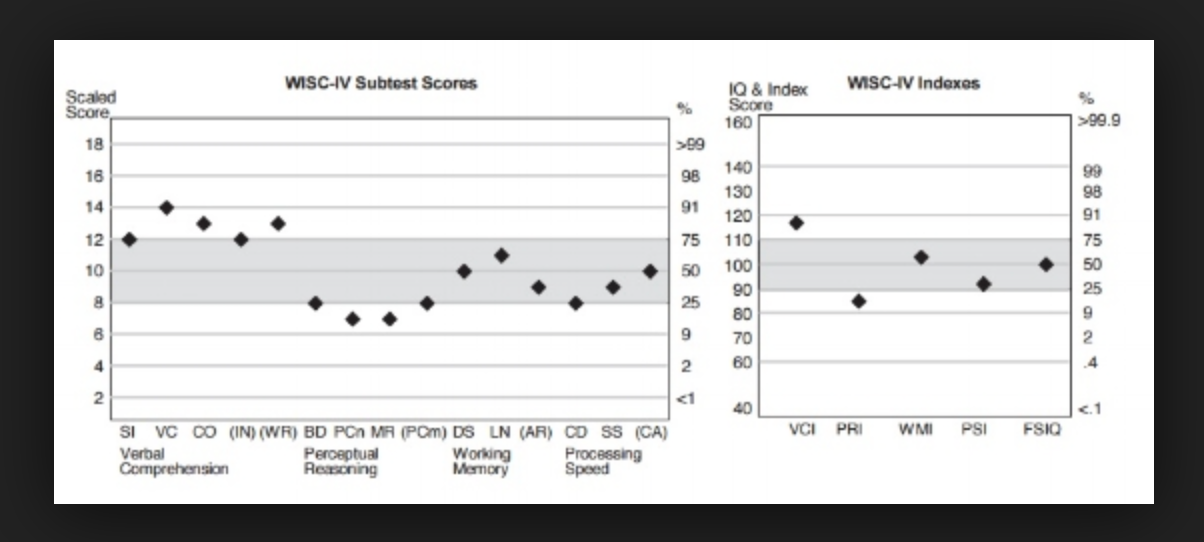
Several scores are obtained from the WISC-III. Scale scores (Verbal and Performance IQ scores) are the summary measures of verbal and performance skills, and the Full Scale IQ is an index of general intellectual functioning.
Factor scores and subtest combinations show other indices of cognitive ability. These scores may provide additional information about learning style and factors underlying scores on the WISC-III. Scale, factor, and subtest scores show strengths and weaknesses when compared to other young people of the same age or to the student’s own pattern of development.
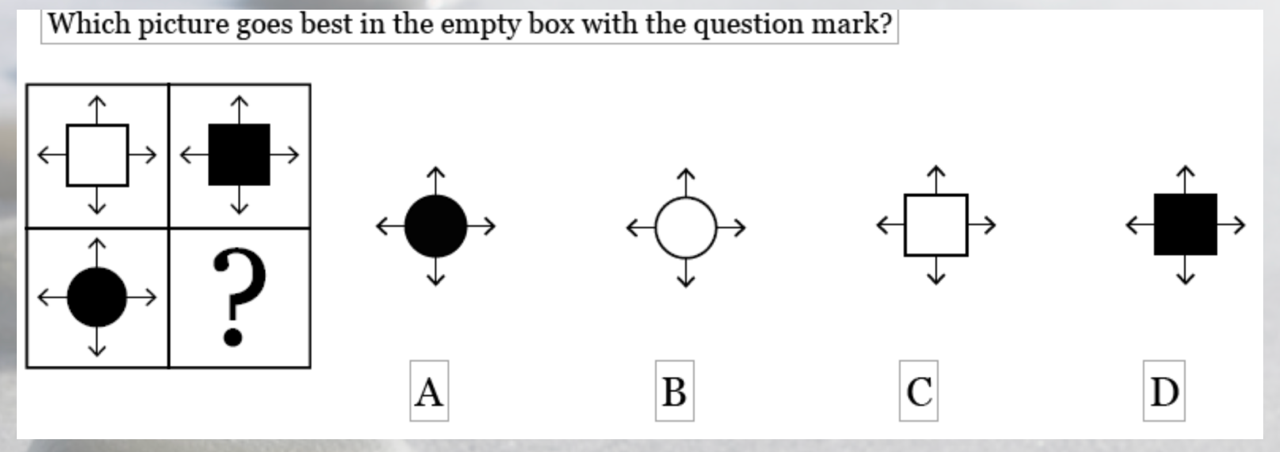
Intelligence tests are samples of problem solving abilities and learned facts, and are good predictors of future learning and academic success. However, there are several factors that the tests do not measure. For example, they cannot determine motivation, curiosity, creative talent, work habits, study skills, or achievement in academic subjects. These should also be considered when interpreting the scores. It must be remembered that test scores can change over time due to chance, error, and many other factors.
|
Subtest Name: Information |
||||
|
Ability |
Factors |
Possible implications of high scores |
Possible implication of low scores |
Instructional Implication |
|
Verbal comprehension Range of factual knowledge Fund of information Long-term memory Acquired knowledge Crystallized ability |
Natural endowment Richness of early environment Quality of pre schooling or schooling Cultural opportunities Interests and reading patterns |
Good range of factual knowledge Good range of information Knowledge of the cultural and educational environment Good memory Enriched background Alertness and interest in the environment Intellectual ambitiousness Intellectual curiosity Urge to collect knowledge |
Poor range of factual knowledge Poor range of information Poor memory Hostility to a preschool-or school-type task Tendency to give up easily Foreign background Lack of achievement orientation |
Stress factual material by having child read newspaper articles, discuss current events and do memory exercises Use other enrichment activities, including calendar activities, science and social studies projects, and , projects involving animals and their function in society |
|
Subtest Name: Similarities |
||||
|
Ability |
Factors |
Possible implications of high scores |
Possible implication of low scores |
Instructional Implication |
|
Verbal comprehension Verbal concept formation Language development Abstract and concrete reasoning abilities Capacity for associative thinking Ability to separate essential from nonessential details Long-term memory Crystallized ability |
Education Cultural opportunities Interests-and reading patterns Flexibility |
Good conceptual thinking Good ability to see relationships Good ability to use logical and abstract thinking Good ability to discriminate fundamental from superficial relationships Good ability to select and verbalize appropriate relationships between two objects or concepts Flexibility of thought processes |
Poor conceptual thinking Difficulty in seeing relationships Difficulty in selecting and verbalizing appropriate relationships between two objects or concepts Overly concrete mode of thinking Rigidity of thought processes Negativism |
Focus on recognition of differences and likenesses in shapes, textures, and daily surroundings Stress language development synonyms and antonyms, and exercises involving abstract words, classifications, and |
|
Subtest Name: Arithmetic |
||||
|
Ability |
Factors |
Possible implications of high scores |
Possible implication of low scores |
Instructional Implication |
|
Verbal comprehension Numerical reasoning ability Mental computation Quantitative knowledge Application of basic arithmetical processes Concentration Attention Short-term memory Long-term memory Mental alertness Acquired knowledge Fluid ability |
Opportunity to acquire fundamental arithmetical processes Quality of pre schooling or schooling Ability to attend to stimuli |
Facility in mental arithmetic Good ability to apply reasoning skills in the solution of mathematical problems Good ability to apply arithmetical skills in personal and social problem-solving situations Good concentration Good attention Good ability to engage in complex thought patterns, mainly for upper-level items Teacher orientation |
Inadequate ability in mental arithmetic Poor concentration Distractibility Anxiety (e.g., over a school-like task or personal- problems) Blocking toward mathematical tasks Lack of interest in school achievement(perhaps associated with rebellion against authority or with cultural background) |
Develop arithmetical skills Develop concentration skills Use concrete objects to introduce concepts Drill in basic skills Provide interesting "real" problems to solve |
|
Subtest Name: Vocabulary |
||||
|
Ability |
Factors |
Possible implications of high scores |
Possible implication of low scores |
Instructional |
|
Verbal comprehension Numerical reasoning ability Mental computation Quantitative knowledge Application of basic arithmetical processes Concentration Attention Short-term memory Long-term memory Mental alertness Acquired knowledge Fluid ability |
Opportunity to acquire fundamental arithmetical processes Ability to attend to stimuli |
Facility in mental arithmetic Good ability to apply reasoning skills in the solution of mathematical problems Good ability to apply arithmetical skills in personal and social problem-solving situations Good concentration Good attention Good ability to engage in complex thought patterns, mainly for upper-level items Teacher orientation |
Inadequate ability in mental arithmetic Poor concentration Distractibility Anxiety (e.g., over a school-like task or personal- problems) Blocking toward mathematical tasks Lack of interest in school achievement(perhaps associated with rebellion against ‘authority or with cultural background) |
Develop arithmetical skills Develop concentration skills Use concrete objects to introduce concepts Drill in basic skills Provide interesting "real" problems to solve |
|
Subtest Name: Vocabulary |
||||
|
Ability |
Factors |
Possible implications of high scores |
Possible implication of low scores |
Instructional |
|
Verbal comprehension Language development Word knowledge Learning’ ability Fund of information Richness of ideas Memory Concept formation Long-term memory Verbal fluency Acquired knowledge Crystallized ability |
Education Cultural opportunities Interests and reading patterns Richness of early environment Quality of pre schooling or schooling |
Good word knowledge Good verbal comprehension Good verbal skills and- language development Good family or cultural background Good pre schooling or schooling Good ability to conceptualize Intellectual striving |
Poor word knowledge. Poor verbal comprehension Poor verbal skills and language development Limited educational or family background Difficulty with verbalization Foreign language background Lack of encouragement of verbalization in family |
Develop working vocabulary Use other verbal enrichment exercises, including Scrabble, analogy, and other word games |
|
Subtest Name: Comprehension |
||||
|
Ability |
Factors |
Possible implications of high scores |
Possible implication of low scores |
Instructional |
|
Verbal comprehension Social judgment Common sense Logical reasoning Application of practical knowledge and judgment in social situations Knowledge of conventional standards of behavior Reasoning Ability to evaluate past experience Moral and ethical judgment Long-term memory Crystallized ability |
Cultural opportunities Quality of pre-schooling or schooling Ability to evaluate and use past experience Development of conscience or moral sense |
Good social judgment and common sense Good ability to recognize when practical judgment and common sense are necessary Knowledge of rules of conventional behavior Good ability to organize knowledge Social maturity Ability to verbalize well Wide experience |
Poor social judgment Failure to take personal responsibility (e.g. Over dependency, immaturity, limited involvement with others) Overly concrete thinking Difficulty in expressing ideas verbally Creativity that leads to looking for unusual solutions Negativism |
Help child understand social mores, customs, and societal activities, such as how other children react to things, how the government works, and how banks operate Discuss the actions of others to help children develop an awareness of social relationships and what others expect of them Role-play situations, such as reporting fires, calling police, and calling the plumber |
|
Subtest Name: Digit Span |
||||
|
Ability |
Factors |
Possible implications of high scores |
Possible implication of low scores |
Instructional |
|
Verbal comprehension Short-term auditory sequential memory Memory span Rote memory Immediate auditory memory Attention span Concentration Auditory sequential processing Immediate rote recall Fluid ability |
Ability to passively receive stimuli Ability to attend to stimuli Auditory acuity and discrimination |
Good short-term auditory memory Good rote memory Good immediate recall ability Ability to attend well in a testing situation Good ability to attend to auditory stimuli Cooperation Flexibility in shifting |
Anxiety Inattention Distractibility A possible learning deficit Difficulty in auditory sequential processing Negativism Poor short-term auditory memory Boredom Difficulty in shifting |
Emphasize listening skills by using sequencing activities, reading a short story and asking the child to recall details, and seeing whether the child can follow directions Use short and simple directions and repeat when necessary Use other memory exercises and memory games |
|
Subtest Name: Picture Completion |
||||
|
Ability |
Factors |
Possible implications of high scores |
Possible implication of low scores |
Instructional |
|
Perceptual organization Ability to differentiate essential from nonessential details Identification of familiar objects (visual recognition) Concentration on visually perceived material Alertness to detail Reasoning Visual processing Visual perception (closure) Visual long-term memory Fluid ability |
Experiences Alertness to environment Ability to work under time pressure Visual acuity and discrimination Willingness to guess when uncertain |
Good perception and concentration Good ability to differentiate between essential and nonessential details Ability to establish a learning set quickly |
Anxiety affecting concentration and attention Preoccupation with irrelevant details Negativism ("nothing is missing") |
Focus on visual learning techniques stressing individual parts that make up the whole Use perceptual activities that focus on recognizing objects, describing objects, and attention to details (e.g., maps and art work) Improve scanning techniques-aimed at identifying missing elements in pictures |
|
Subtest Name: Coding and Digit Symbol – Coding |
||||
|
Ability |
Factors |
Possible implications of high scores |
Possible implication of low scores |
Instructional |
|
Processing speed Visual-motor coordination or dexterity Speed of mental operation Psychomotor speed Short-term visual memory Visual recall Attention Concentration Symbol-associative skills visual sequential processing Fluid ability |
Rate of motor activity Motivation Visual acuity and discrimination Attention span Ability to work under time pressure |
Visual-motor dexterity Good attention and concentration Sustained energy or persistence Ability to learn new material associatively and reproduce it with speed and accuracy- Good motivation Desire for achievement Good visual sequential processing |
Visual-motor coordination difficulties Distractibility Anxiety Visual defects Poor pencil control Poor motivation Excessive concern for detail in reproducing symbols exactly Lethargy or boredom Impulsivity |
Use visual-motor learning exercises, such as developing a code for matching geometric figures and numbers, learning Morse Code, and working on tracing activities |
|
Subtest Name: Picture Arrangement |
||||
|
Ability |
Factors |
Possible implications of high scores |
Possible implication of low scores |
Instructional |
|
Perceptual organization Planning ability Interpretation of social situations Nonverbal reasoning ability Attention to details Alertness Visual sequential processing Common sense Anticipation of consequences Fluid ability |
Cultural opportunities Ability to work under time pressure Ability to infer cause-and-effect relationships |
Planning ability Alertness to detail Forethought Sequential thought processes Good ability to synthesize parts into intelligible wholes |
Difficulty with visual organization and sequential processing Difficulty in anticipating events and their consequences Inattentiveness Anxiety Failure to use cues Difficulty in working under time pressure Impulsivity Poor visual acuity and discrimination |
Focus on cause-and-effect relationships, logical sequential presentations, and part-whole relationships Use story completion exercises Discuss alternative behaviors and endings in stories and events |
|
Subtest Name: Block Design |
||||
|
Ability |
Factors |
Possible implications of high scores |
Possible implication of low scores |
Instructional |
|
Perceptual organization Visual-motor co-ordination Spatial visualization Visual processing Abstract conceptualizing ability Analysis and synthesis Speed of mental processing Fluid ability |
Rate of motor activity Color vision Ability to work under time pressure Visual acuity and discrimination Trial-and-error learning |
Good visual-motor-spatial integration Good conceptualizing ability Good spatial orientation in conjunction with speed, accuracy, and persistence Good analyzing and synthesizing ability Speed and accuracy in sizing up a problem Good hand-eye-coordination Good nonverbal reasoning ability Good trial-and-error methods |
Poor visual-motor-spatial integration Visual-perceptual problems Poor spatial orientation Difficulty in working under time pressure Impulsivity Poor ability to size up a problem Poor analyzing and synthesizing ability Poor hand-eye coordination Poor nonverbal reasoning ability |
Use puzzles, blocks, spatial-visual tasks, perceptual tasks involving breaking down an object and building it up again, and art work with geometric forms and flannel board Focus on part-whole relationships and working with a model or a key |
|
Subtest name: Letter – number Sequencing |
||||
|
Ability |
Factors |
Possible implications of high scores |
Possible implication of low scores |
Instructional |
|
Working memory Attention Concentration Short-term auditory memory Memory span Information processing Cognitive flexibility Fluid ability |
Ability to passively Receive stimuli Motivation |
Good short-term auditory memory Good working memory Good attention and concentration Persistence |
Poor short-term auditory memory Anxiety Inattention Distractibility A possible learning deficit Impulsivity Negativism |
Emphasize listening skills by using sequencing activities Use short and simple directions and repeat when necessary Use memory exercises and memory games |
|
Subtest name: Matrix Reasoning |
||||
|
Ability |
Factors |
Possible implications of high scores |
Possible implication of low scores |
Instructional |
|
Perceptual organization Reasoning ability Classification ability Ability to form analogies Attention to detail Concentration Spatial ability Knowledge of part-whole relationships Fluid ability |
Persistence Motivation Ability to work toward a goal Ability to use trial and error |
Good perceptual organization Good reasoning ability Good attention to detail Persistence Good concentration |
Poor perceptual organization Poor reasoning ability Lack of attention to detail Negativism Impulsivity Poor concentration |
Use puzzles, blocks, spatial-visual tasks, perceptual tasks involving breaking down an object and building it up again, and art work with geometric forms and flannel board |
|
Subtest Name: Sentences |
||||
|
Ability |
Factors |
Possible implications of high scores |
Possible implication of low scores |
Instructional |
|
Verbal comprehension Short-term auditory memory Rote memory Immediate auditory memory Mention concentration Auditory sequential processing Verbal facility Fluid ability |
Ability to passively Receive stimuli Language development |
Good short-term auditory memory Good rote memory Good immediate recall ability Ability to attend well in a testing situation Good ability to attend to auditory stimuli |
Anxiety Inattention Distractibility Difficulty with auditory sequential processing Negativism |
Emphasize listening skills by using sequencing activities, reading a short story and asking the child to recall details, and seeing whether the child can follow directions Use short and simple directions and repeat when necessary Use other memory exercises and memory games |
|
Subtest Name: Geometric Design |
||||
|
Ability |
Factors |
Possible implications of high scores |
Possible implication of low scores |
Instructional |
|
Perceptual organization Perceptual-motor ability Visual-motor Organization Visualization |
Motor ability |
Good perceptual-motor ability |
Poor perceptual-motor ability |
Use pencil and crayons to develop fine motor skills |
|
Subtest Name: Object assembly |
||||
|
Ability |
Factors |
Possible implications of high scores |
Possible implication of low scores |
Instructional |
|
Perceptual organization Visual processing Visual-motor coordination Ability to synthesize concrete parts into meaningful wholes Spatial ability Speed of mental processing Fluid ability |
Rate of motor activity Familiarity with figures Persistence Experience with part-whole relationships Ability to work toward an unknown goal Ability to work under time pressure |
Good visual-motor coordination Good ability to visualize a whole from its parts Ability to perceive a whole, with critical understanding of the relationships of the individual parts Experience in assembling puzzles Persistence |
Visual-motor difficulties Visual-perceptual problems Poor planning ability Difficulty in perceiving a whole Minimal experience with construction tasks Limited interest in assembly tasks Limited persistence Difficulty in working under time pressure Impulsivity |
Develop perceptual and psychomotor skills through guided practice in assembling parts into familiar configurations Reinforce persistence Work with puzzles and activities centering on recognition of missing body parts Employ construction, cutting, and pasting activities Focus on interpretation of wholes from minimal cues |
|
Subtest Name: Mazes |
||||
|
Ability |
Factors |
Possible implications of high scores |
Possible implication of low scores |
Instructional |
|
Perceptual organization Planning ability Foresight Visual-motor control Hand-eye coordination Attention Concentration Visual processing Spatial scanning |
Visual-motor organization Visual acuity and discrimination Ability to delay action |
Good perceptual organization Planning efficiency Speed and accuracy. Good ability to follow instructions Sustained attention |
Poor visual-motor organization Inefficient planning Difficulty in delaying action Impulsivity Inability to sustain attention Boredom |
Focus on planning skills, directionality, visual discrimination, and other paper-and-pencil activities emphasizing planning and anticipation |
|
Subtest Name: Symbol search |
||||
|
Ability |
Factors |
Possible implications of high scores |
Possible implication of low scores |
Instructional |
|
Processing speed Perceptual discrimination Speed of mental operation Psychomotor speed Attention Concentration Short-term visual memory Visual-motor coordination Cognitive flexibility Fluid ability |
Rate of motor activity Motivation Ability to work under time pressure Visual acuity and discrimination Trial-and-error learning |
Good processing speed Good perceptual discrimination ability Good attention and concentration Sustained energy or persistence Good motivation or desire for achievement Good short-term visual memory |
Poor processing speed Poor perceptual discrimination ability Distractibility Visual defects Lethargy or boredom Poor motivation Anxiety Difficulty in working under time pressure Impulsivity Poor short-term visual memory |
Use visual-motor scanning exercises, such as looking at two or more objects and deciding if they are the same or different |
|
Subtest Name: Full Scale |
||||
|
Ability |
Factors |
Possible implications of high scores |
Possible implication of low scores |
Instructional |
|
General intelligence. Scholastic aptitude Academic aptitude Readiness to master a School curriculum |
Natural endowment Richness of early environment Extent of schooling Cultural opportunities Interests Rate of motor activity Persistence Visual-motor organization Alertness |
Good general intelligence Good scholastic aptitude Readiness to master a school curriculum |
Poor general intelligence Poor scholastic aptitude Lack of readiness to master school curriculum |
Focus on language development activities Focus on visual learning activities Develop concept information skills Reinforce persistence |
|
Subtest Name: Verbal Scale or Verbal Comprehension index |
||||
|
Ability |
Factors |
Possible implications of high scores |
Possible implication of low scores |
Instructional |
|
Verbal comprehension Application of verbal skills and information to the solution of new problems Verbal ability Ability to process verbal information Ability to think with words |
Natural endowment Richness of early environment Extent of schooling Cultural opportunities Interests |
Good verbal comprehension Good scholastic aptitude Knowledge of the cultural environment Good concept formation Readiness to master school curriculum Achievement orientation |
Poor verbal comprehension Poor scholastic aptitude Inadequate understanding of the cultural milieu Poor concept formation Bilingual background Foreign background Lack of readiness to master school curriculum Lack of achievement orientation |
Stress language development activities Use verbal enrichment activities Focus on current events Use exercises involving concept formation |
|
Subtest Name: Performance Scale or Perceptual Organization Index |
||||
|
Ability |
Factors |
Possible implications of high scores |
Possible implication of low scores |
Instructional |
|
Perceptual organization ability to think in terms of visual images and manipulate them with fluency, flexibility, and relative speed ability to interpret or organize visually perceived material within a time limit Verbal ability Ability to form relatively abstract concepts and relationships without the use of words |
Natural endowment Rate of motor activity Persistence Visual-motor organization Alertness Cultural opportunities Interests |
Good perceptual organization Alertness to detail Good nonverbal reasoning ability Persistence Ability to work quickly and efficiently Good spatial ability. |
Poor perceptual organization Lack of alertness to detail Poor nonverbal reasoning ability Lack of persistence Inability to work quickly and efficiently Poor spatial ability |
Focus on visual learning activities Focus on part-whole relationships Use spatial-visual tasks Encourage trial-and-error activities Reinforce persistence Focus on visual planning activities Improve scanning techniques |
|
Subtest Name: Animal Pegs |
||||
|
Ability |
Factors |
Possible implications of high scores |
Possible implication of low scores |
Instructional |
|
Perceptual organization Attention Goal awareness Concentration Finger and manual dexterity Learning ability Short-term visual memory Processing speed Visual sequential Processing fluid ability |
Rate of motor activity |
Visual-motor dexterity Good concentration Sustained energy or persistence Ability to learn new material associatively and reproduce it with speed and accuracy Good motivation or desire for achievement |
Visual-motor coordination difficulties Distractibility Visual defects Poor short-term visual memory |
Use visual-motor learning exercises, such as sorting coins and putting different- colored objects in bins |
|
Subtest Name: Freedom from Distractibility index and Working Memory |
||||
|
Ability |
Factors |
Possible implications of high scores |
Possible implication of low scores |
Instructional |
|
Ability to sustain attention Short-term memory Numerical ability Encoding ability Ability to use rehearsal strategies Ability to shift mental operations on symbolic material Ability to self-monitor |
Natural endowment |
Good ability to sustain attention Good short-term memory Good numerical ability Good encoding ability Good rehearsal strategies Good ability to shift mental operations on symbolic material Good ability to self-monitor |
Difficulty in sustaining attention Distractibility Anxiety Short-term retention deficits Encoding difficulties Poor rehearsal strategies Difficulty in rapidly shifting mental operations on symbolic material |
Develop attention skills Focus on small meaningful units of instruction |
|
Subtest name: Processing Speed index |
||||
|
Ability |
Factors |
Possible implications of high scores |
Possible implication of low scores |
Instructional |
|
Processing speed Perceptual discrimination Speed of mental operation Psychomotor speed Attention Concentration Short-term visual memory Visual-motor coordination Cognitive flexibility Fluid ability |
Rate of motor activity Motivation Visual acuity and discrimination Attention span Ability to work under time pressure |
Good processing speed Good perceptual discrimination ability Good attention and concentration Sustained energy or persistence Good motivation or desire for achievement Good short-term visual memory |
Poor processing speed Poor perceptual discrimination ability Distractibility Visual defects Lethargy or boredom Poor motivation Anxiety Difficulty in working under time pressure Impulsivity |
Develop visual-motor skills Develop concentration skills Focus on learning codes Focus on selecting numbers that match |













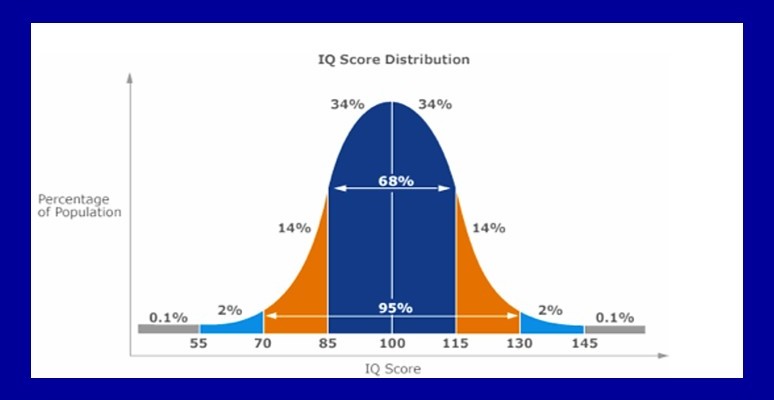
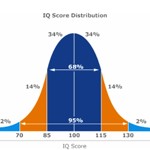



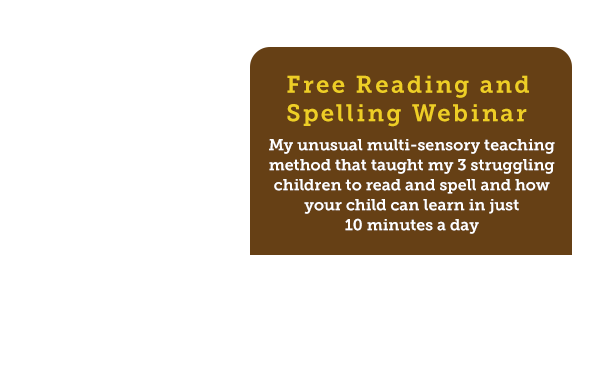

Do you have a similar table that applies to WISC-V?
Trying to get this sorted now. Kind regards Liz
This test is out of date and is no longer used. The current test is the WISC-V.
Thanks Lynn working on getting a more updated version created
it would be great in the same format but wisc 5
As others have already pointed out, the WISC-III that is described in your “How do you read a WISC?” article is significantly outdated. The WISC-III was published in 1991 (26 years ago) and the next version, WISC-IV came out in 2003 (14 years ago), and we have now been using the WISC-V since 2014 (3 years). Many of the subtests described in the article have either been changed a great deal or are long-since gone. Similar information about the WISC-V can be easily found by looking up WISC-V on the Pearson Clinical website or simply by googling WISC-V. I would also add that the title “How do you read a WISC?” is a bit inaccurate as well; “reading” a WISC is being able to interpret the individual scores as well as the profile or pattern of scores. Sorry to sound negative but I get nervous about giving information to the public and practicing outside of one’s area of professional and clinical expertise.
Thanks for the voice of reason, Jennifer – just got this in an email, and was pretty shocked.
Yes, thank you Jennifer! I panicked a bit when I opened the newsletter this article was a part of. Very misleading for parents and puts professionals in an awkward situation. Having a basic understanding of various standardized test scores and how they relate to the bell curve and what each test or subtest measures should not be confused with an expert’s training in test interpretation. I’m all for supporting parents and others interested in understanding test scores, but they should always be able to and feel comfortable in asking the person conducting the test to explain it first hand.